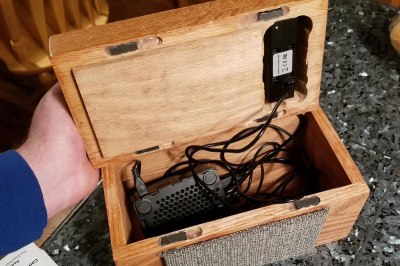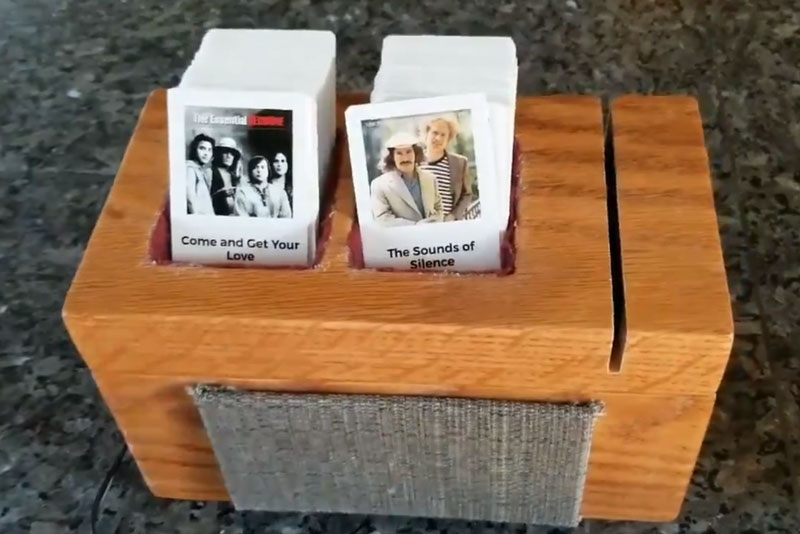The family of [Chris Patty] decided that their holiday gifts would have to be handmade. So, he decided to make something new for his father: a jukebox with a twist. Instead of a touchscreen or web interface, his jukebox uses swipe cards. To play a track, you find the card for the song you want to hear, swipe it, and the jukebox plays the requested track. The whole thing is built into a wooden box that hides its digital nature, which is built using a Raspberry Pi and a credit card stripe reader.
 This is a lovely, clean build that shows how you don’t always have to use the standard ways to control a device. With a bit of thought and planning it is possible to make technology easier to use for those who are intimidated by screens and blinking lights, by creating different ways of controlling them. We’ve looked at many jukebox builds that use interesting interfaces, including QR codes and this awesome build that replaces the guts of a 1969 Wurlitzer 3100 with an Arduino.
This is a lovely, clean build that shows how you don’t always have to use the standard ways to control a device. With a bit of thought and planning it is possible to make technology easier to use for those who are intimidated by screens and blinking lights, by creating different ways of controlling them. We’ve looked at many jukebox builds that use interesting interfaces, including QR codes and this awesome build that replaces the guts of a 1969 Wurlitzer 3100 with an Arduino.
[Chris] has decided that he is going to write up the plans for the device soon, and possibly run a Kickstarter to sell it. If you are interested in getting more details of this impressive and clean build, you can sign up at Getjook.com.
[Via the Verge]















I like this a lot. I’m more partial the hoveeman version of this: https://github.com/hoveeman/music-cards just because NFC is pretty cheap, and it’s leaning on home assistant to do multi room audio. The stand along jukebox is a great build though for those that are less technically inclined, but I feel like NFC would be easier to use depending on how the scanner was presented to the user.
This combines the benefits of a modern mass storage music database with the feeling of loading up a record/tape/CD like in the good old days.
All that is left is the booklet with lyrics, artwork, etc.
What would be the best format for these ‘records’?
Playing card size? CD or even LP?
Combining title and artwork can be easily scripted based on metadata in the files and then printed in bulk.
But then you would need some method to process all the prints into ‘records’ that are sturdy enough for repeated use.
My only complaint is that the speaker cover just look stuck on, besides that its great. And one suggestion, include album cards that will play the whole album.
Yes, I am one of those sad luddites that doesn’t have twitter account.
So, did he encode the “credit cards” with data that pointed to the music file, or did he just use whatever what was already on the cards?
I don’t see it mentioned.
Storing a file’s path or some command onto the card is one option.
The data on the card is limited so you could not put very long commands or paths onto it.
https://en.wikipedia.org/wiki/Magnetic_stripe_card
Another option would be to give each card a unique id sequence and then maintain a database on the computer that links each id to the appropriate action.
In reqards to your last option.
How would I encode a credit card?
I do have a credit card reader, would I have to heat the mag stripe to its Curie point and then slip it through the reader somehow making the reader write to the blank card?
No heating required, there are writers just for this purpose:
https://www.google.com/search?q=credit+card+writer
Or make something from an old casseteplayer’s write and erase heads.
Hey quick question Ren. Are you from Minnesota? I have a feeling I might know you.
Quick thought, why don’t you ask the guy you know in real life?
@Greenaum – because I haven’t seen him in 15 years and I don’t know how to reach him.
Not “from” Minnesnowta, but living [t]here, currently working in Owatonna.
One solution is to store a hash of the track to be played.
And this is easier than having a keyboard or a display and navigation buttons? Seems foolish to me unless it was just an excuse to play with a card reader and writer. If that is what it was, and you had fun with it, great. When the first NV ram came out I spent a while building a silly counter that held it’s count in it. It was totally non practical but I just wanted to play with the stuff, and that I did. I would never try and pass it off as a practical device though.
I suspect he may have gone this way because his dad was elderly. Try explaining how to use a computer to an elderly person and you’ll start to wonder if there are more simple methods.
I built a similar device ( https://hackaday.com/2016/09/04/music-player-for-the-ability-impaired/ ) when a family member lost her ability to use her mini-stereo (which was quite simple to use), so there is definitely a need for these devices. Larger buttons or screens is not always the answer.
For the device I made, one placed the song (card) onto a reader and the device started playback, she could understand that concept very well and used it daily up until her death.
It would give you the ‘old school’ feel of having to put a physical record into a physical player instead of navigating through stuff on a screen.
If I were making this for a parent using the same sort of UI, I think I would have gone with a bar code or QR code instead. That way, replacement cards could just be printed rather than adding in ordering the mag stripe cards and programming them.
I love this concept. I like that it simplifies the UI into a physical computing dynamic. It’s a great interface for the jukebox concept brilliantly executed here, and it could be applied in so many ways. Those mag stripe card readers are less than $20. I’d like to see a restaurant where the menu was a bunch of those cards and you could swipe them at your table. If the chef wants to change up the menu for a night, no need to print new menus, just lay out a different selection of cards on the tables.
And you could make them playing cards on the other side, so customers have a game to play while spending some time eating and chatting. i mean if that’s the type of the restaurant. Or a bar.
Having worked at a credit card bank that stopped letting customers have pictures on their credit cards because the swiping of the cards would wear out the picture, causing customers to stop using it to avoid further damaging the picture of their pet/grandchild/care/whatever and running up charges on whatever other card they had… I’ve got to wonder how quickly the pictures on the cards here will get damaged from swiping and need to be replaced.
A version that reads barcodes on the back of CDs and albums would be nice.
I would lose interesting in creating the cards very quickly.